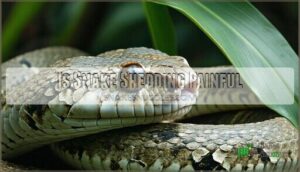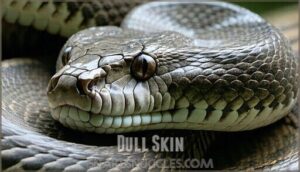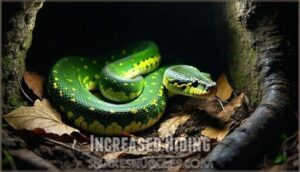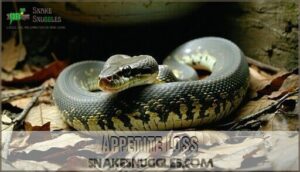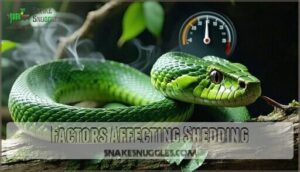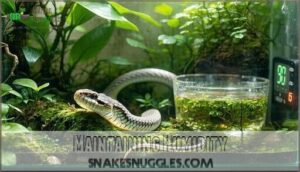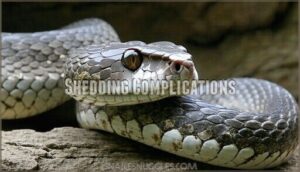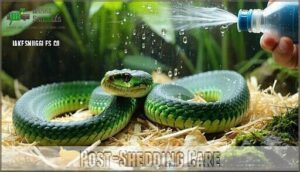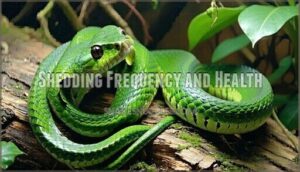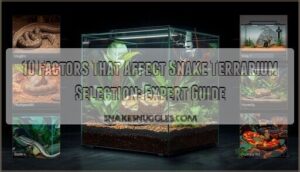This site is supported by our readers. We may earn a commission, at no cost to you, if you purchase through links.

It’s not, for a healthy snake, at least.
As you observe your snake shedding, you’ll notice it’s more about vulnerability and stress.
Moisture between the old and new skin makes it a relatively comfortable process.
You’ll want to make certain your snake’s environment is just right, with proper humidity and temperature, to make shedding easier.
Now, let’s get into the details of what to expect and how to support your snake during this process, and you might be surprised at what you can do to make it smoother.
Table Of Contents
- Key Takeaways
- Snake Shedding Basics
- Is Snake Shedding Painful
- Shedding Signs and Behavior
- Factors Affecting Shedding
- Environmental Considerations
- Assisting Shedding Snakes
- Shedding Complications
- Post-Shedding Care
- Supporting Shedding Comfort
- Shedding Frequency and Health
- Frequently Asked Questions (FAQs)
- Is it painful for snakes to shed?
- Is molting painful for snakes?
- Do snakes feel pain when cut?
- Can snakes eat during shedding process safely?
- How long does snake shedding take normally?
- Do all snakes shed skin in same way?
- Can improper shedding cause long term damage?
- Are there any home remedies for stuck sheds?
- Conclusion
Key Takeaways
- You’ll find that snake shedding isn’t typically painful for them, but it can be stressful, so you’ll want to ensure their environment is comfortable and stress-free.
- To support your snake’s shedding process, you’ll need to maintain proper humidity levels, provide rough surfaces for them to rub against, and monitor their temperature, as these factors can affect their comfort and stress levels.
- You should be aware of potential shedding complications, such as retained shed, skin injuries, and infections, and take steps to prevent or address them, like providing a humid hide, using shedding aids, and seeking veterinary care if needed.
- After your snake finishes shedding, you’ll need to adjust their care routine to help them recover and return to normal, including handling precautions, feeding recommendations, and ensuring proper hydration, as this period requires careful attention to their overall health and well-being.
Snake Shedding Basics
If you’ve ever wondered whether your snake experiences discomfort during shedding, you’re not alone in this concern.
Snakes can feel discomfort during shedding, but proper care helps minimize it
Understanding the natural process of ecdysis helps you provide better care and recognize when your pet needs extra support during this vulnerable time, which is crucial for their well-being and your ability to offer extra support.
Ecdysis Process
Snake shedding, or ecdysis, happens when specialized lymphatic fluid builds between old and new skin layers, triggering enzymatic activity that breaks down cellular bonds.
This natural skin separation process lets your snake slip out of its old skin by rubbing against rough surfaces.
The complete cycle duration typically spans 7-14 days, transforming temporary snake discomfort into fresh, vibrant new skin.
Hormonal Influence
You’ll find that hormonal changes play a pivotal role in snake shedding, triggered by a hormone cascade.
Growth hormones and thyroid influence regulate ecdysis, ensuring a smooth process.
Ecdysis triggers are linked to hormonal fluctuations, affecting shedding regulation and the overall snake shedding experience.
This process is essential for skin rejuvenation and parasite removal.
Skin Rejuvenation
You’ll notice skin rejuvenation occurs through cellular turnover and epidermal renewal during snake shedding, boosting collagen and skin elasticity.
While reducing scars, which can cause discomfort, irritation, but not necessarily pain.
Is Snake Shedding Painful
You’re probably wondering if snake shedding is painful. Generally, it’s not, thanks to a lubricant layer between the old and new skin.
Snake shedding is usually painless due to a lubricating layer between old and new skin.
However, shedding can cause discomfort, anxiety, and irritation due to skin sensitivity. Snakes may exhibit behavioral indicators like reduced activity and increased hiding.
To mitigate pain and discomfort, maintaining ideal humidity and temperature is key. Proper care can prevent shedding discomfort and sensory impact.
By understanding snake shedding, you can help your pet navigate this process comfortably, reducing anxiety and irritation. A healthy snake will typically shed to remove old skin. This knowledge will help you provide the best care for your snake’s shedding needs.
Shedding Signs and Behavior
You’ll notice some distinct signs when your snake is about to shed, including cloudy eyes and dull skin.
As you observe your snake’s behavior, you’ll see increased hiding, appetite loss, and other changes that indicate shedding is near.
So it’s vital to recognize these signs to provide the best care.
Cloudy Eyes
As you observe your snake’s behavior, look out for cloudy eyes, a sign of impending shedding.
This blue phase indicates vision impairment, causing discomfort, and potential lubrication issues with eye caps.
This condition signals the start of the shed cycle, a vital aspect of snake shedding, including potential pain.
Dull Skin
You’ll see skin dullness before shedding, a pre-shed look.
Causes of dullness include old skin loosening, signaling the snake is preparing to shed, and this can be a sign of painful shedding if not properly cared for, affecting the snake’s skin and overall health.
Snakes also display bluish-gray eyes during this period, which can be an indicator of the snake’s readiness to shed.
Increased Hiding
You’ll find your snake hiding more as shedding approaches, seeking security and stress reduction.
Hiding benefits your pet, but observation challenges arise.
Monitor your snake’s hiding duration to verify it’s not a sign of snake shedding stress, which can be painful, affecting their behavior and overall well-being.
Appetite Loss
You’ll notice your snake’s appetite loss before shedding, a common sign of shedding inappetence.
Digestion impact is minimal, but refeeding strategies are essential after shedding to prevent nutritional deficiencies and health implications.
Ensuring your snake recovers smoothly from snake shedding inappetence, is crucial for its overall health and well-being.
Factors Affecting Shedding
You’ll find that several factors affect your snake’s shedding process, including its age, species, and environmental conditions.
As you care for your snake, this is vital, such as humidity levels, to make certain a healthy and successful shed.
Age and Species
You’ll discover that juvenile snakes shed frequently, every 2-6 weeks, while adult snakes shed less often, 2-4 times a year, due to species variations and growth impact on snake shedding intensity.
Environmental factors also influence species-specific shedding variations.
Environmental Conditions
You control environmental factors affecting snake shedding, such as enclosure size, substrate choice, and lighting needs.
A thermal gradient and enrichment items also play a role.
Dry conditions can cause issues, so maintaining proper humidity levels is essential for healthy snake shedding, reducing stress and complications, which is crucial for healthy snake care.
Humidity Levels
You manage humidity levels to aid snake shedding, using a hygrometer and misting techniques.
A shedding box helps, especially with regional variations in humidity.
Proper humidity prevents incomplete snake shedding, or dysecdysis, ensuring a healthy shed.
Monitor humidity levels closely to support your snake’s shedding process, which is crucial for a healthy shed.
Environmental Considerations
You play a vital role in creating a comfortable environment for your snake to shed its skin.
By providing the right conditions, including humid hides, water bowls, and temperature gradients, you can help make the shedding process as smooth and stress-free as possible for your pet.
Humid Hides
You can create DIY hides to maintain humidity levels, reducing snake shedding stress and pain.
Use hide materials that prevent mold, considering your snake’s preference for a humidity gradient, and ensuring a comfortable humid hide for shedding.
A key element for successful shedding is a proper snake enclosure, which is crucial for a comfortable and humid environment.
Water Bowls
You’ll want a water bowl that’s the right size for your snake, with clean water and proper placement to maintain humidity levels, creating a moist environment that aids in snake shedding, and helps your snake stay hydrated and comfortable.
Consider a heavier bowl to prevent tipping, as stability is important for your snake, which is crucial for maintaining stability and ensuring your snake’s overall well-being in its environment.
Temperature Gradients
You’ll set up a temperature gradient, a key to snake shedding comfort, with a basking spot and a cool side, allowing thermoregulation and reducing snake shedding discomfort.
As heat sources impact the shedding environment and potential snake pain.
Assisting Shedding Snakes
You’ll want to assist your snake during shedding by maintaining proper humidity and providing rough surfaces to rub against.
By doing so, you’ll help make the shedding process as smooth and stress-free as possible for your pet.
Maintaining Humidity
You’ll need to monitor humidity levels for snake shedding.
Consider these:
- Humidity sources
- Hygrometer placement
- Enclosure size
Proper humidity is key to a successful shed, so make certain you’re meeting your species’ needs with accurate humidity monitoring. You may need a reptile humidity gauge for precise readings.
Providing Rough Surfaces
You’ll provide rough surfaces to aid snake shedding, reducing injury risk.
Offer natural options like rocks or tree branches with varied texture importance, a vital shedding aid for snake skin during the snake shedding process, helping prevent complications in snake behavior.
You can find suitable shedding products online.
Monitoring Temperature
When monitoring temperature for snake shedding, consider a temperature gradient.
Key factors include:
- Accurate thermometers
- Thermostat placement
- Basking spot
- Night temperatures
Gradient importance is crucial to prevent snake shedding pain, ensuring a healthy snake environment with proper temperature control.
Shedding Complications
You’ll want to be aware of potential shedding complications, such as retained shed, skin injuries, and infections, which can affect your snake’s health.
By recognizing these issues, you can take steps to prevent or address them, ensuring your snake’s shedding process is as smooth and painless as possible.
Retained Shed
You’ll encounter retained shed, a common issue.
| Stuck Shed Causes | Aiding Removal | Preventing Retention |
|---|---|---|
| Dysecdysis | Soaking | Humidity |
| Incomplete shedding | Shedding aids | Veterinary intervention |
Retained shed, or stuck skin, requires careful handling to prevent further complications and ensure a healthy recovery from dysecdysis.
Skin Injuries
Skin injuries are a common shedding complication. You might notice scale damage, like tan, red, or brown patches. Environmental factors often contribute to snake skin tearing. Rough surfaces, used for shedding, can cause snake shedding sores if conditions are poor.
Proper wound care is essential to reduce infection risk. What can you do?
- Address humidity issues.
- Provide smooth surfaces.
- Monitor for signs of snake skin irritation.
- Seek veterinary care for snake skin discomfort to prevent scar tissue.
By following these steps, you can help prevent snake skin tearing and ensure the health of your snake. Remember, proper wound care is crucial in reducing the risk of infection.
Infections
Bacterial infections can creep up when retained shed creates perfect breeding grounds for harmful microorganisms.
You’ll notice swelling, discharge, or foul odors around stuck skin patches.
Fungal infections thrive in overly humid conditions, appearing as white or gray patches.
Fungal infections can be caused by poor sanitation practices.
Parasitic infections worsen during dysecdysis when compromised skin can’t defend itself properly.
Septicemia and abscesses require immediate veterinary attention to prevent serious complications.
Post-Shedding Care
Once your snake completes shedding, you’ll need to adjust your care routine to help them recover and return to normal.
This period requires careful attention to handling, feeding schedules, and ensuring proper hydration as your snake readjusts to their fresh new skin, which is crucial for their overall health and proper hydration.
Handling Precautions
After addressing shedding complications, you’ll want to examine handling precautions.
Snakes can be sensitive after shedding.
Minimize contact, and observe your snake for signs of handling readiness.
- Bright, soft skin
- Relaxed posture
- No hissing
- Calm movements
- Normal tongue flicks
Avoid handling to reduce stress.
Snake handling after shedding requires care due to post-shedding sensitivity.
Snake stress is real, so avoid handling if retained skin is present.
Feeding Recommendations
After your snake finishes shedding, its appetite often returns with a vengeance.
Wait a day or two before post-shed feeding to aid snake digestion. Offer appropriately sized snake food—think pre-shed feeding size, not a Thanksgiving feast.
Keep feeding frequency steady and, if needed, add dietary supplements. Remember, overfeeding won’t help, but patience with snake shedding surely does, and it requires careful management to avoid digestion issues.
Hydration Levels
Sometimes, staying hydrated is half the battle for a happy, healthy snake.
You’ll want to:
- Offer fresh water daily and change it out, even if it looks clean.
- Encourage soaking—many snakes love a spa day!
Watch for dehydration signs like wrinkly skin, and keep humidity levels in check.
Monitor drinking frequency after each shed, to ensure your snake is getting enough water and staying healthy.
Supporting Shedding Comfort
Helping your snake stay comfortable during shedding isn’t rocket science, but it does take a little effort and attention.
You’ll want to make sure their home is humid, stress-free, and equipped with the right tools—otherwise, you might’ve one cranky, itchy reptile on your hands.
Humidity Control
If you want to master snake shedding humidity, proper humidity levels are key.
Use a hygrometer—accuracy matters here!
Misting techniques and your substrate choice both help control moisture.
Check enclosure ventilation—too much airflow or inconsistent humidity spells trouble.
Remember, every species needs its own balance, so don’t wing it.
A fresh bowl of water helps, too, and maintaining the right environment is crucial for snake shedding, with hygrometer being a vital tool.
Shedding Aids
Beyond maintaining proper humidity levels, you’ll find several tools that make shedding easier for your snake. Think of these as your snake’s personal spa treatments during their vulnerable time.
Here are key shedding aids to examine:
- Humidity Boosters – Commercial shedding aids with glycerine and jojoba oil condition skin
- Rubbing Surfaces – Cork bark, textured wood pieces, or rough branches for friction
- Soaking Options – Shallow warm water bowls for extended bathing sessions
- Shedding Boxes – Humid hides with damp moss or paper towels inside
These snake shedding assistance tools work together to create ideal conditions. Water availability becomes vital during this process, as snakes naturally seek moisture. A humid hide doubles as both shelter and moisture source, while soaking helps soften stubborn skin patches that won’t budge naturally.
Reducing Stress
You’ll want to create a calm environment that helps your snake feel secure during this vulnerable time.
Minimal handling is key – resist the urge to check on them constantly.
Provide plenty of hiding places and reduce noise around their enclosure.
This approach minimizes snake stress and anxiety, promoting stressfree shedding.
A relaxed snake will shed more easily than one that’s constantly on edge, which is why a calm environment is crucial for promoting stressfree experiences.
Shedding Frequency and Health
You’ll notice your snake’s shedding frequency depends on its age and growth rate, with younger snakes shedding more often than adults.
Understanding these patterns helps you monitor your pet’s health and spot any issues that might need a vet’s attention.
Growth Rate
As you observe your snake’s growth, note that shedding frequency depends on its growth rate.
Juvenile snakes shed more often due to rapid growth, while adult sheds occur less frequently, influenced by dietary impact and species variation.
This affects the overall snake shedding process and growth.
Shedding Intensity
You’ll notice shedding intensity varies with age and species.
Younger snakes shed more frequently due to rapid growth, while adults shed less often.
Shedding frequency and health impact are correlated, with some species experiencing more irritability and anxiety during shedding, affecting their overall well-being and sensitivity.
Veterinary Checkups
You schedule regular exams with a reptile veterinarian for parasite screening and skin health checks.
Consider:
- Preventative care
- Expert advice
- Medical concerns to guarantee your snake’s well-being, especially during snake shedding, and receive proper veterinary care to address medical concerns.
Frequently Asked Questions (FAQs)
Is it painful for snakes to shed?
You’ll find that snakes’ shedding process, although potentially stressful, isn’t typically painful for them, it’s a natural process.
Is molting painful for snakes?
You’ll be relieved to know that molting isn’t typically painful for snakes, it’s a natural process, although they may experience some discomfort or anxiety during shedding.
Do snakes feel pain when cut?
You wonder if snakes feel pain when cut, like a slashing storm, but research suggests they don’t, as their nervous system doesn’t process pain like humans do.
It’s a different tale.
Can snakes eat during shedding process safely?
You shouldn’t feed your snake during shedding, as it can cause stress and discomfort, so it’s best to wait until after the process is complete.
How long does snake shedding take normally?
You’ll notice snake shedding typically takes 7-14 days, starting with dull skin and ending with the old layer coming off in one piece, a natural process for growth and renewal.
Do all snakes shed skin in same way?
You’ll find that not all snakes shed their skin in the same way, as species, age, and growth rates influence their shedding processes and frequencies, making each one unique.
Can improper shedding cause long term damage?
You can cause long-term damage if improper shedding isn’t addressed, leading to infections, skin issues, and other health problems in your snake.
Are there any home remedies for stuck sheds?
You can try gently soaking or using a damp cloth to help remove stuck sheds, and wrapping your snake in warm wet towels can also aid in removing retained skin.
Conclusion
In the end, you’ll find that the snake shedding process isn’t painful, but it can be stressful.
You’re likely wondering, is snake shedding painful process, and the answer is no, for healthy snakes.
By following these tips, you’ll be helping your snake shed its skin with ease, making the process relatively comfortable.
- https://www.rentonvet.com/pet-health/care-of-snakes/shedding-ecdysis/
- https://www.petcovergroup.com/au/shedding-in-snakes-dos-and-donts/
- https://www.blueplanetaquarium.com/education/why-do-snakes-shed-their-skin/
- https://www.petmd.com/reptile/snake-shedding-skin
- https://www.redtailboas.com/forum/boa-general-care-husbandry/boa-care/33274-does-it-hurt-to-help-a-snake-shed

